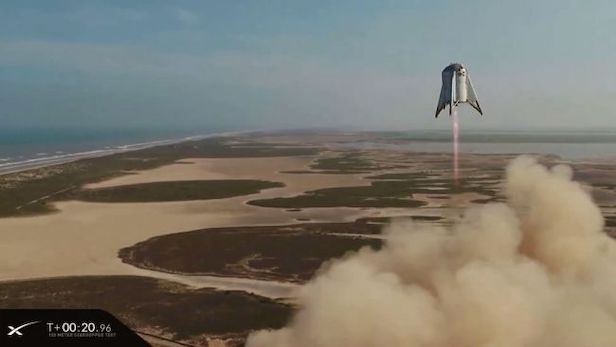SpaceX Starhopper rocket prototype aces highest (and final) test flight
Starhopper is passing the test-flight torch to orbital prototypes

SpaceX launched its Starhopper rocket prototype on its highest flight ever on 27 August 2019. Image credit: SpaceX
Starhopper’s biggest leap was also its last.
SpaceX’s first prototype for its Mars-colonising Starship vehicle aced its final test flight on 27 August 2019, rising several hundred feet off the ground at the company’s facility in the tiny South Texas town of Boca Chica, United States.
Starhopper lifted off just after 6:00 p.m. EDT (10:00 p.m. GMT; 5:00 p.m. local Texas time), reached a hover altitude and then flew sideways to touch town at a separate nearby landing pad. The entire flight lasted just 57 seconds.
“Congrats SpaceX team!!” SpaceX CEO Elon Musk wrote on Twitter just after the flight.
The ceiling for today’s flight was 150 metres (about 500 feet), SpaceX founder and CEO Elon Musk said via Twitter this week. That limit was imposed by the U.S. Federal Aviation Administration, which grants licenses for launches and test flights.
So, the recent leap was quite a bit higher than Starhopper’s three previous forays off of terra firma. The first two, conducted in early April, produced barely any separation between the craft and the ground; Starhopper was tethered for safety’s sake both times. The prototype was first unleashed on 25 July 2019; the vehicle rose an estimated 20 metres (65 feet) into the Texas sky.
Today’s flight was originally scheduled to take place on 26 August. But that attempt was aborted just before liftoff, likely because of an issue with the igniter on Starhopper’s Raptor engine, Musk said.
Starhopper is powered by a single Raptor, the next-generation engine that SpaceX is developing for use on Starship and its giant rocket partner, Super Heavy. The 100-passenger Starship will have six Raptors and the Super Heavy will sport 35, with space for two more on the rocket, Musk has said.
Those numbers could change, however. The billionaire entrepreneur has promised to give a Starship design update soon after Starhopper’s final flight.
Starhopper now hands the test-flight reins to two orbital prototypes, which SpaceX calls Starship Mk1 and Mk2. The company is building Mk1 in Boca Chica and Mk2 on Florida’s Space Coast, reasoning that a little intra-company competition will improve the final Starship design.
Both Mk1 and Mk2 will be powered by at least three Raptors, Musk has said. The test launches of these prototypes will pave the way for operational Starship flights, which could begin as early as 2021.
Those first few commercial liftoffs will probably loft communications satellites. But the first passenger trip could follow shortly thereafter; Japanese billionaire Yusaku Maezawa has booked a Starship flight around the Moon, with a target launch date of 2023.
Mars missions will be next, if all goes according to plan. Indeed, that’s SpaceX’s ultimate goal; Musk has repeatedly said that he founded the company back in 2002 primarily to help humanity colonise the Red Planet and become a multiplanet species.
Starhopper’s flying days may be done, but the stubby prototype will be retasked rather than put out to pasture.
“Yes, last flight for Hopper. If all goes well, it will become a vertical test stand for Raptor,” Musk said via Twitter on Saturday.
Keep up to date with the latest news in All About Space – available every month for just £4.99. Alternatively you can subscribe here for a fraction of the price!




